Carl Zeiss
Aussichtsfernrohr 12x60
Das hier gezeigte Monokular ist nicht eindeutig einzuordnen. Die Berechnungen der Vergrößerung ergeben ein 12x60 oder 15x60 Monokular. Das im Zeiss Katalog 1905 gezeigte Aussichtsfernrohr mit kurzer Brennweite 12x60 hat laut Prospekt auswechselbare Okulare und ein nicht drehbares Prismengehäuse, welches bei diesem Exemplar vorhanden ist (vgl. halbes Asembi Bild 6), ein ähnliches Zwischenstück gibt es im Prospekt nur bei einem 12x80. Von der Größe her könnte es auch ein frühes 15x60 Aussichtsfernrohr (Mon. F. 15x60) sein, vielelicht ist es aber jedoch auch nur eine Hälfte eines 15x60, wofür das Drehgelenk zum Einstellen des Augenabstandes bei binokularen Modellen spricht sowie die Deckelbeschriftung nur mit "Carl Zeiss Jena" im Linsenlogo und ein angeschweißter Messingteil am Objektivtubusansatz, der eine Lücke im Aluminium verdeckt. Dort könnte der Verbindungssteg zur zweiten Hälfte herausgesägt worden sein. Die Ummantelung mit Leder spricht für eine zivile Ausführung, könnte aber je nach Ursprung des Instruments auch nachträglich angebracht worden sein. Das Leder sowie die passende Ledertransporttasche weisen ein hohes Alter auf. |
Observing Telescope 12x60
The monocular depicted here cannot be identified precisely. Calculating the magnification it can be a 12x60 ord 15x60 monocular. The observing telescope 12x60 shown in the 1905 Zeiss catalogue with short focal length should have changeable eyepieces and a non-turnable prism housing according to the catalgue, whereas the ocular of this model are fixed and the housing is turnable (cf. half Asembi, pic. 6). A similar intermediate, probably swiveling part is only depicted at a 12x80 telescope in the brochure. Regarding size it may be an early 15x60 observing telescope (Mon. F. 15x60). Again, it also might be jsut the half of a 15x60 bincoular. Some proofs could be the swivel joint to adjust interpupillary distance, cover plate markings with only "CArl Zeiss Jena" within the lens logo, and eventually a bending brass plate soldered to the swivel joint box which covers a gap in the aluminium wall beneath – a sign that the joining bridge was cut off there and covered with the brass plate.. The leather covering proves the monocular rather to be a civilian model, though it might be fitted to the tube and housing after refurbishing. At least the leather and the matching leather case are very old. |
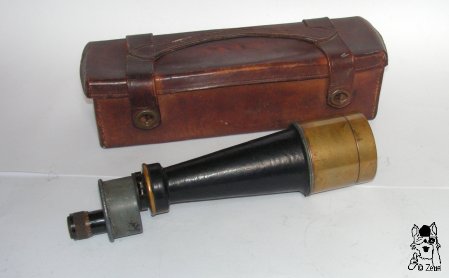
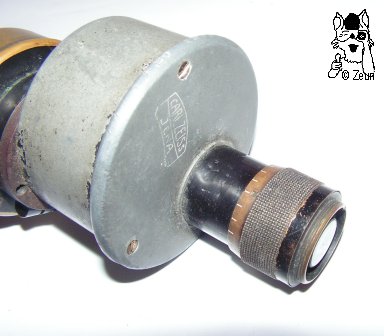
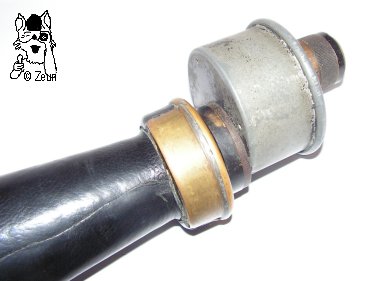
| Das Monokular hat ein rundes Prismengehäuse mit Porro-2-System. Die Lackierung fehlt. Das Okular hat eine umlaufende Dioptrienskala, wie üblich markiert bei Null und jeweils Fünf. Die Augenmuschel fehlt (eine Augenmuschel eines späteren 15x60 passt). Der Deckel ist dreifach verschraubt. Das Drehgelenk zwischen Prismendose und Objektivtubus hat eine Ringschelle zum Festzurren. Der breitere dosenförmige Ansatz des Objektivtubus hat ebenfalls drei Befestigungsschrauben und ist aus schwarz lackiertemn Messing. Die Seiten sind mit Leder ummantelt, bis auf das angelötete Messingteil. Der konische Objektivtubus ist lederummantelt. Am geraden Objektivabschluss ist eine ausziehbare Sonnenblende aus Messing. An dieser ist keine Befestigung für einen Schutzdeckel zu sehen. Eine Montagevorrichtung für ein Stativ fehlt ebenfalls. | This monocular has a round prism housing with porro 2 prisms. The original lacquering is worn off. The dioptre scale runs around the ocular tube completely and is marked at zero and five to each side. The eyecup is mssing, but a 15x60 eyecup of another model would fit. The top cover plate has three screws. The swivel joint between prism box and objective tube has a clip collar to tighten the movement. The borader box-shaped part of the objective tube also has three screws. It is made of brass and painted black. The sides are covered with leather apart from the soldered-on brass piece. The conical tube has a leather covering, too. The straight end objective frame has an extendable brass sunshade. The latter has no lug for a protection cap. There is not a tripod attachment either. |
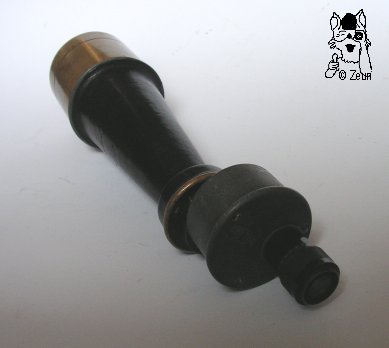
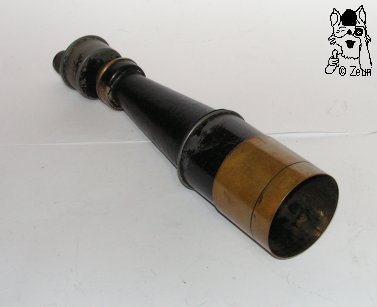
| Das Monokular wiegt 1096g, der Lederbehälter 710g. Es ist 320-328mm lang; die Sonnenblende lässt sich bis zu 47mm ausziehen. Das gerade Enstück, das von der Sonnenblende komplett umhüllt wird, ist 72mm lang und 80mm im Durchmesser. Der 15cm lange konische Objektivtubus verbreitert sich von 38mm auf 72mm im Durchmesser. Der 21mm hohe dosenförmige Ansatz ist 52mm im Durchmesser, die Schelle 39mm, das 33mm hohe Prismengehäuse ist 59mm bzw. 64mm am Deckel im Durchmesser. Das Okularstück ist 24,5mm, der Fokussierungsring 28mm im Durchmesser. | The monocular weighs 1096g, the leather case weighs 710g. It measures 320-328mm in length. The sunshade extends up to 47mm. The straight end piece 72mm long, has a 80mm diameter, and is covered completely by the closed sunshade. The 15cm conical objective tube icnreases from 38mm to 72mm in diameter. The 21mm tall box-shaped broader part of the objective tube is 52mm in diameter, the clip collar 39mm, and the 33mm tall prism housing measures 59mm and 64mm at its cover plate in diameter. The eyepiece has a 24.5mm, the focusing ring has a 28mm diameter. |
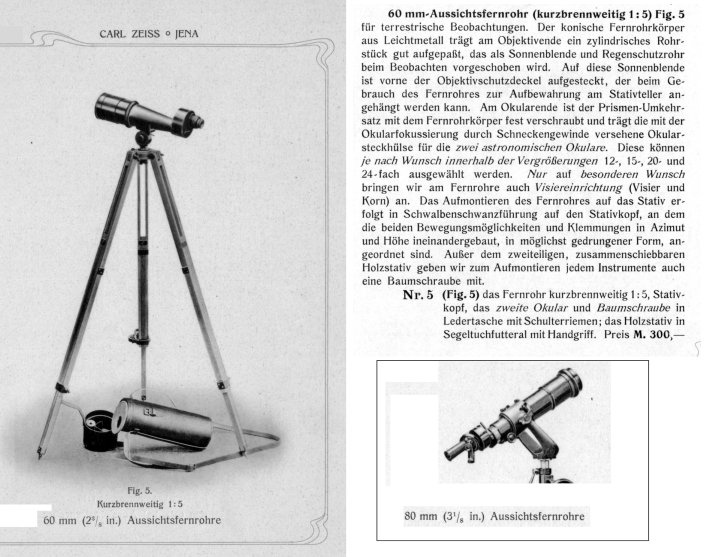
Collage: Zeiss Prospekt 1905 – collage: Zeiss brochure 1905
Fotos: Zeun

